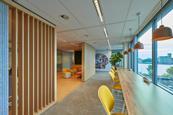Cost model: Incorporating sustainability in purpose-built student accommodation
Private investment is driving change, and meeting sustainability demands within strict time, cost and labour limitations is the challenge
Cost model: exploring the advantages of surgical hubs and barn theatres
Capacity issues within the NHS are driving innovative ways of working. This cost model looks at the advantages and costs of surgical hubs and barn theatres
Cost model: What solutions are there for low embodied carbon office fit-outs?
Office fit-outs score poorly on whole-life emissions, because short tenancies lead to repeated refitting.聽Aecom鈥檚 Lauren Lemcke, Danielle Rowley and Dave Cheshire report on new solutions
Cost model: Evaluating the construction cost impact of the 好色先生TV Safety Act
The implications of the legislation, a look at real-world applications, and a notional model for cost increases on a higher-risk building
Cost model: How construction can meet the data centre challenge
With the demand for data storage soaring, the construction industry must find ways to rise to this challenge efficiently and sustainably, against a background of land and energy scarcity
Cost model: Evolving the design and build of community diagnostic centres
The rollout of these centres is intended to cut long elective care waiting lists, provide value for taxpayers and decarbonise the NHS, but achieving all three is a challenge
Cost model: Making sports stadiums fit for purpose
Today鈥檚 sports stadiums face new challenges and require redeveloping for audiences in a diverse and sustainable way.聽Will Goring of Turner & Townsend Alinea and Philip聽Johnson of Populous outline the issues.
Cost model: Delivering sustainable hotels
Hotels are competing as somewhere to stay and as places to see and be seen. Delivering sustainable, health-conscious and imaginatively designed spaces is the challenge
Cost comparison: Tower construction in Toronto and London
T&T Alinea compare recent high-rise history in two global cities whose skylines have undergone dramatic change, including the costs of a typical tall office building in each
Cost model: Low-carbon office developments 鈥� new-build vs refurbishment
Multiple pathways are emerging to support the development of low-carbon offices, whether through new-build or, increasingly, reuse and adaptation
Cost model: A guide to life sciences lab fit-out
Life science labs are in high demand. Identifying the right spaces to nurture innovation 鈥� and fitting them out flexibly and sustainably 鈥� offers opportunities
Cost model: Universities need to answer tough questions about their priorities
Aecom鈥檚 Rory Armstrong and Steven聽Jenkins explain what鈥檚 happening in the tertiary education sector and offer a cost model of a typical building
Cost model: Build-to-rent
Build-to-rent offers a solution to low housing supply and stable returns for investors and developers 鈥� if they can meet the demands of a quickly evolving tenant base
Cost model: 好色先生TV brownfield
Regenerating previously used land offers multiple environmental, social and cost advantages but there are many factors to consider
Cost model: Labs in the sky
Record levels of investment into the life science sector and an increasingly limited supply of space have encouraged laboratory buildings to enter the high-rise realm
Cost model: School buildings
Amid rising prices, schools developers must strike a balance between meeting cost expectations and providing fit-for-purpose, sustainable buildings for the next generation of learners
Cost comparison: Upgrade or renew?
To meet net zero targets, owners must bring buildings up to scratch. Whether to refurb or demolish and rebuild is the question
Cost model: Distribution warehouses
The combined impact of inflation plus materials and labour shortages is stretching developers of logistics centres 鈥� yet demand for this building type remains high
Cost model: Cancer care centres
The challenge is to deliver cancer centres that provide highly effective, technologically advanced care and support as well as research and education
Cost model: Impact of building regulation changes
Changes this June to the 好色先生TV Regulations Parts L and F will raise standards on decarbonisation and ventilation. What are the cost implications?








































